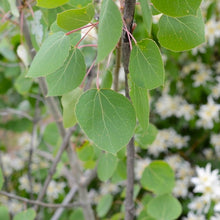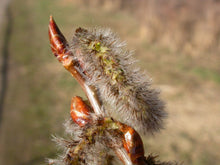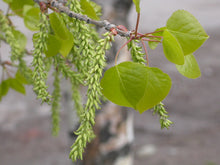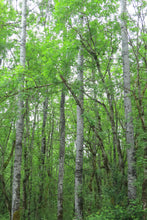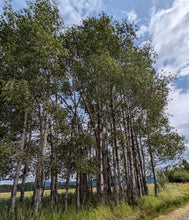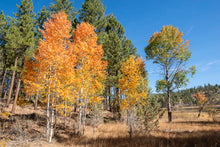
Populus tremuloides
There are few things more serene than laying on your back, in the dappled shade of a mature quaking aspen, listening to the quiet rustle of its bright green leaves in the summer breeze. This tree is as beautiful as they come; smooth light-gray bark, branches adorn with dangling, distinct male or female catkin flowers each spring, and iconically trembling leaves that shift into stunning golden hues each fall.
- Plant type/canopy layer: deciduous, large tree
- Size at maturity: 40-50' tall, 20-25' wide
- Light requirements: full sun
- Moisture requirements: moist soil
- Bloom time: March - May
- Growth rate/ease: fast growing, easy to grow
- Wildlife support: this tree is a caterpillar host and larval food source for native butterflies and moths and is generally attractive to many species of insects, which in turn supports an abundance of birds, especially while rearing/feeding young, including hummingbirds and woodpeckers; new growth, leaves and bark are important browsing materials for deer, elk, moose, and many small animals like rabbits, porcupines, and beaver; branches and logs are a choice building material for beaver lodges - they can drag the logs up to 400ft!
- Native habitat/range: common in wet to dry, open and closed woodlands and forests, edges of meadows and prairies, talus-slopes and canyon-heads, and sites of human disturbance such as timber cuts, mine tailings, gravel pits, quarries, roadsides, from sea level to 3000m, across much of the northern United States and Canada. Portland Plant List - yes
- Special features & uses: landscape uses include raingardens and edges of large meadowscapes, for erosion control and in hedgerows and windbreaks; human uses include timber for items like crates, pallets, wood shavings, matchsticks, tongue depressors, and pellets for fuel and pulp for paper - particularly in the northeastern USA where it is more abundant.
Gardening with Quaking Aspen: This attractive, no-fuss tree will thrive in full sun areas with moist soils. It is thicket forming, capable of sending suckers long distances until eventually forming an incredibly picturesque grove that is one singular organism, interconnected underground. This growth habitat makes it an excellent choice for managing erosion, establishing windbreaks and creating fairy magic on large properties. But it should be avoided, or planted with a root barrier, in smaller urban yards and near sewers, drainage systems or other utilities.
Photo Credit 1 (leaves closeup): © Alison Northup, some rights reserved (CC-BY)
Photo Credit 2 & 3 (buds and catkins): "Populus tremuloides" by Matt Lavin is licensed under CC BY-SA 2.0.
Photo Credit 4 (mature form): © Garth Harwood, some rights reserved (CC-BY)
Photo Credit 5 (trunks): © Ed Alverson, some rights reserved (CC-BY)
Photo Credit 6 (grove): © Dominic Gentilcore, some rights reserved (CC-BY)
Photo Credit 7 (fall yellow): © Dominic Gentilcore, some rights reserved (CC-BY)







